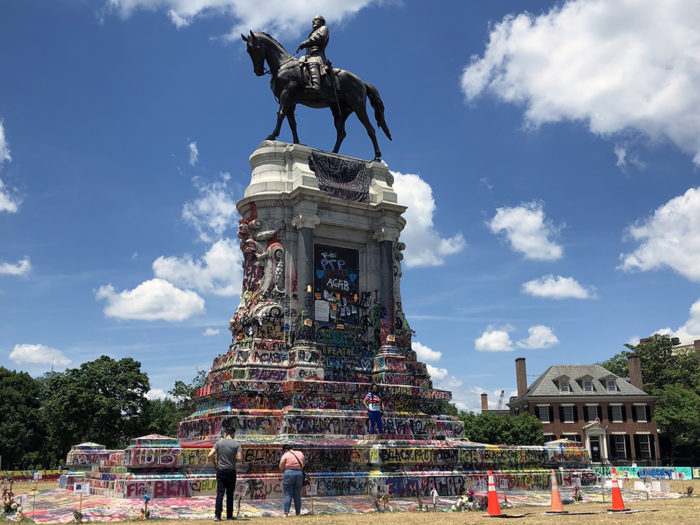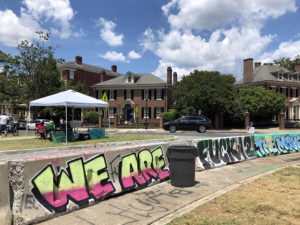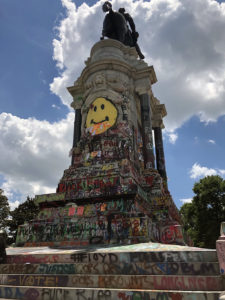
The Robert E. Lee Monument has become a focal point and daily gathering place of the protests in Richmond. (BizSense file photos by Michael Schwartz)
Correction/Clarification: An earlier version of this story incorrectly reported that Judge Cavedo’s recusal takes him immediately off the case filed by William C. Gregory. Cavedo’s recusal relates to him disqualifying himself from the proposed consolidation of the Gregory case and a similar matter also pending in Richmond Circuit Court.
Another Richmond Circuit Court judge has distanced himself from one of the lawsuits looming over the Robert E. Lee statue on Monument Avenue – and this time it’s the judge who lives in the neighborhood.
Judge Bradley Cavedo on Wednesday disqualified himself from presiding over the pending consolidation of two cases seeking to stop the removal of the Lee statue.
The first case, over which Cavedo presides, is a deed dispute filed last month by William C. Gregory, who claims to be a descendant of the family that sold the land on which the Lee Monument sits to the state in the late 1800s. The suit claims Gov. Ralph Northam’s desire to take down the monument violates that deed and his efforts should be blocked.
Cavedo’s rulings in the Gregory case earned headlines when on June 18 he put in place an indefinite injunction preventing Northam from following through on his pledge to take down the state-owned monument. The now-graffiti-covered Lee roundabout has become the center of much of the protesting in Richmond since the death of George Floyd.
The second lawsuit, filed by Monument Avenue resident Helen Marie Taylor and five of her unnamed neighbors, makes similar claims, as well as arguing that their property values would be harmed should Lee come down. While that case is being heard by Judge W. Reilly Marchant, Taylor’s attorney has filed to have the case combined into the Gregory matter.
Cavedo’s July 1 recusal came a day after BizSense reported the continued streak of judge recusals from both the Gregory and Taylor cases. Cavedo’s move marks the seventh time a judge has recused himself or herself from one of the two cases since their filing in early June.
The report also pointed out the proximity of Cavedo’s home to the monument – he lives just off Monument Avenue, a block over from the street’s main drag and near the J.E.B Stuart and Lee statues.

With Monument Ave. homes behind it, graffiti covers a barrier installed by the state on the perimeter of the grassy area surrounding the Lee statue.
His home, according to state records, is within the boundaries of the Monument Avenue Historic District, which has National Historic Landmark designation from the U.S. Department of the Interior.
Taylor and her fellow plaintiffs, among other claims, argue in their case that removing the Lee Monument would result in the loss of that landmark designation, as well as a loss of related favorable tax treatment and reduction in property values.
“Plaintiffs enjoy certain tax benefits as a consequence of their ownership of real estate within that district, which will be adversely affected by any actions of defendants to remove, damage or alter the Lee statue,” the case asserts.
While the Gregory case does not involve an argument over property values, the consolidation, if approved on Cavedo’s watch, could have led him to preside over a dispute about property values in his own neighborhood.
Cavedo didn’t explicitly say in the July 1 court notice that his recusal is due to his residing in the neighborhood, but it did reference the fact that the Taylor case may soon be consolidated into the Gregory case.
“I am so situated in respect to Judge Marchant’s case…as to render it improper for me to preside. Therefore, I recuse myself,” Cavedo’s filing states.

The Lee Monument is covered nearly head to toe in paint of all colors, except for the statue itself.
Cavedo’s notice was labeled as a “disqualification order,” whereas the other judges who removed themselves from the two cases did so under “recusal orders.”
The Gregory suit is still pending, with Gregory and attorney Joseph Blackburn given 21 days by Cavedo to amend and refile their complaint.
Cavedo took the Gregory case over from Judge Beverly Snukals after she recused herself June 8.
The Taylor matter is now in the hands of Judge W. Reilly Marchant after five of his peers recused themselves. That case is in the process of being amended. No ruling has yet been made on combining the two suits.
It’s the job of Chief Judge Joi Taylor to assign replacements in the instance of a recusal, a process that’s typically done through a rotation. Taylor also recused herself from the Taylor dispute due to a “pecuniary financial interest of myself or a family member in the outcome of the case,” according to a June 30 filing.
None of the other recusals included any detail as to why the judges were stepping away from the case. Judges in Virginia are not required to explain their reasons for recusal. And only an individual judge can decide whether to recuse him or herself.
If no judge in a given jurisdiction is able to take a case, the chief judge will call the Supreme Court of Virginia, which will appoint a judge from another jurisdiction to take over.

The Robert E. Lee Monument has become a focal point and daily gathering place of the protests in Richmond. (BizSense file photos by Michael Schwartz)
Correction/Clarification: An earlier version of this story incorrectly reported that Judge Cavedo’s recusal takes him immediately off the case filed by William C. Gregory. Cavedo’s recusal relates to him disqualifying himself from the proposed consolidation of the Gregory case and a similar matter also pending in Richmond Circuit Court.
Another Richmond Circuit Court judge has distanced himself from one of the lawsuits looming over the Robert E. Lee statue on Monument Avenue – and this time it’s the judge who lives in the neighborhood.
Judge Bradley Cavedo on Wednesday disqualified himself from presiding over the pending consolidation of two cases seeking to stop the removal of the Lee statue.
The first case, over which Cavedo presides, is a deed dispute filed last month by William C. Gregory, who claims to be a descendant of the family that sold the land on which the Lee Monument sits to the state in the late 1800s. The suit claims Gov. Ralph Northam’s desire to take down the monument violates that deed and his efforts should be blocked.
Cavedo’s rulings in the Gregory case earned headlines when on June 18 he put in place an indefinite injunction preventing Northam from following through on his pledge to take down the state-owned monument. The now-graffiti-covered Lee roundabout has become the center of much of the protesting in Richmond since the death of George Floyd.
The second lawsuit, filed by Monument Avenue resident Helen Marie Taylor and five of her unnamed neighbors, makes similar claims, as well as arguing that their property values would be harmed should Lee come down. While that case is being heard by Judge W. Reilly Marchant, Taylor’s attorney has filed to have the case combined into the Gregory matter.
Cavedo’s July 1 recusal came a day after BizSense reported the continued streak of judge recusals from both the Gregory and Taylor cases. Cavedo’s move marks the seventh time a judge has recused himself or herself from one of the two cases since their filing in early June.
The report also pointed out the proximity of Cavedo’s home to the monument – he lives just off Monument Avenue, a block over from the street’s main drag and near the J.E.B Stuart and Lee statues.

With Monument Ave. homes behind it, graffiti covers a barrier installed by the state on the perimeter of the grassy area surrounding the Lee statue.
His home, according to state records, is within the boundaries of the Monument Avenue Historic District, which has National Historic Landmark designation from the U.S. Department of the Interior.
Taylor and her fellow plaintiffs, among other claims, argue in their case that removing the Lee Monument would result in the loss of that landmark designation, as well as a loss of related favorable tax treatment and reduction in property values.
“Plaintiffs enjoy certain tax benefits as a consequence of their ownership of real estate within that district, which will be adversely affected by any actions of defendants to remove, damage or alter the Lee statue,” the case asserts.
While the Gregory case does not involve an argument over property values, the consolidation, if approved on Cavedo’s watch, could have led him to preside over a dispute about property values in his own neighborhood.
Cavedo didn’t explicitly say in the July 1 court notice that his recusal is due to his residing in the neighborhood, but it did reference the fact that the Taylor case may soon be consolidated into the Gregory case.
“I am so situated in respect to Judge Marchant’s case…as to render it improper for me to preside. Therefore, I recuse myself,” Cavedo’s filing states.

The Lee Monument is covered nearly head to toe in paint of all colors, except for the statue itself.
Cavedo’s notice was labeled as a “disqualification order,” whereas the other judges who removed themselves from the two cases did so under “recusal orders.”
The Gregory suit is still pending, with Gregory and attorney Joseph Blackburn given 21 days by Cavedo to amend and refile their complaint.
Cavedo took the Gregory case over from Judge Beverly Snukals after she recused herself June 8.
The Taylor matter is now in the hands of Judge W. Reilly Marchant after five of his peers recused themselves. That case is in the process of being amended. No ruling has yet been made on combining the two suits.
It’s the job of Chief Judge Joi Taylor to assign replacements in the instance of a recusal, a process that’s typically done through a rotation. Taylor also recused herself from the Taylor dispute due to a “pecuniary financial interest of myself or a family member in the outcome of the case,” according to a June 30 filing.
None of the other recusals included any detail as to why the judges were stepping away from the case. Judges in Virginia are not required to explain their reasons for recusal. And only an individual judge can decide whether to recuse him or herself.
If no judge in a given jurisdiction is able to take a case, the chief judge will call the Supreme Court of Virginia, which will appoint a judge from another jurisdiction to take over.
Six judges recuse for unstated and dubious reasons?? No doubt due to fear of the mob, whose puppet-masters seek to dominate others and understand only force. They are the true fascist, taliban totalitarians who use the very nazi tactics they condemn. When will a man or woman jurist of principle stand up and do what is right?
And by the way, isn’t it true that the events of the last several weeks have vaporized all “gun control” arguments? Law-abiding citizens should carry a gun and know how to use it, now more than ever!
Sue the mayor and the Democrats.
If you can’t make a rational or persuasive argument without calling the people who disagree with you fascists or Nazi’s (guess we can add the “taliban” to that list) …. then you just can’t make a rational or persuasive argument.
Upon his surrender, General Lee said that he’d never again wear the CSU uniform. He said, “I am an American.” Before his death, he requested of his admirers that no statues of him be erected else it reopen the wounds of the Civil War. Both his requests were dishonored by this statue and others of him in his CSU uniform. His prediction was prescient. The wounds of the war and the slavery it intended to preserve will remain open until the statues are permanently removed. Let’s look to the future Richmond!
Well said